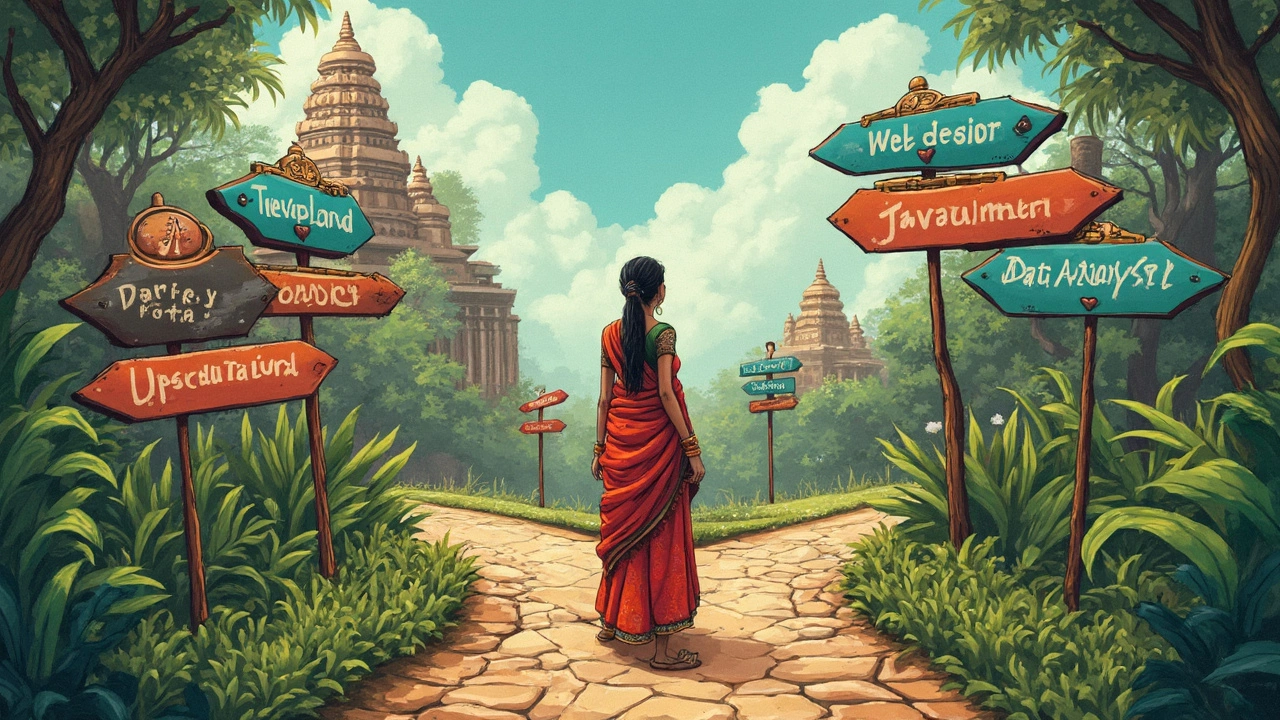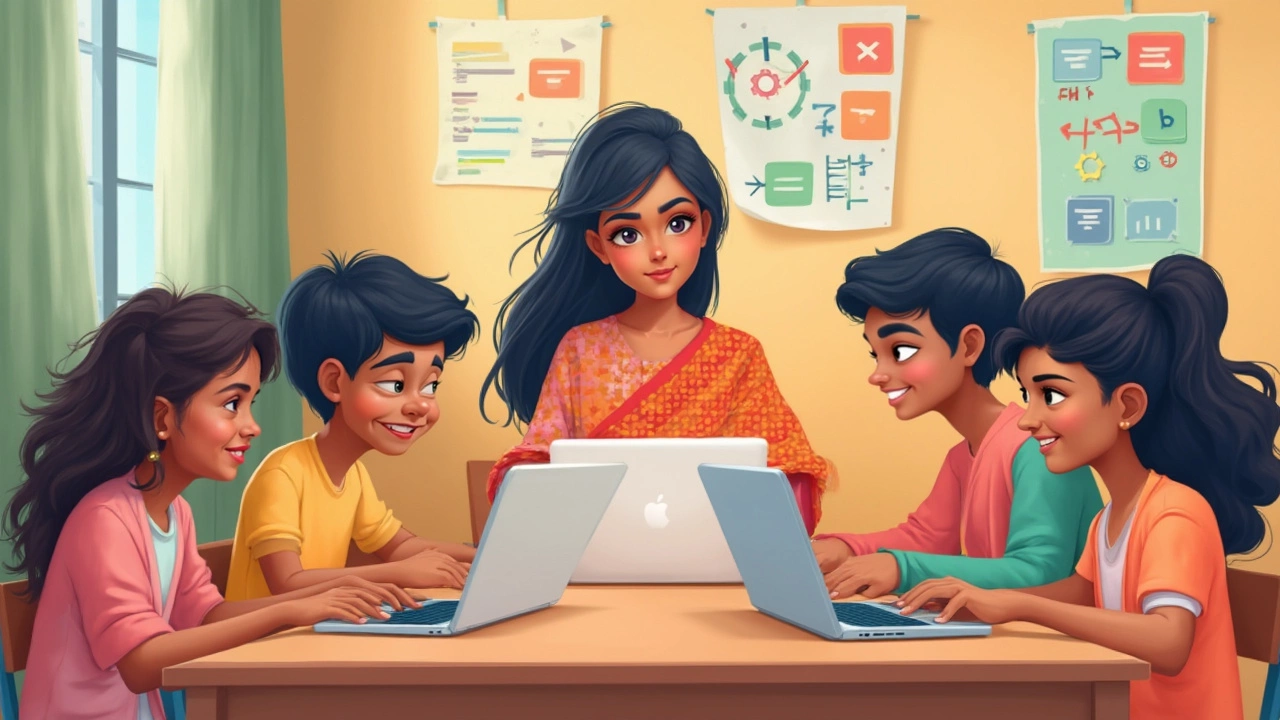Which Coding Language Should I Learn First? A Real-World Guide

So you're ready to jump into coding, but there’s a wall of options staring back at you. Python, JavaScript, Java, even Scratch—how are you supposed to know which one to choose? You’re definitely not alone. The good news: you don’t have to guess. The language you pick now isn’t forever, but choosing something that matches what you actually want to build will make learning way less painful.
Here’s something most people won’t tell you: the 'best' language depends almost entirely on your goals. Want to create websites? Apps? Games? Crunch data in spreadsheets? Your answer points straight to your ideal starting language. And don’t worry, you’re not signing a lifelong contract with your first pick. Most pros jump around languages as their projects change. Start simple, get good, and you’ll pick up the next one much faster.
If you’re just looking for a straight answer—Python is hands-down the best first language for most beginners. But there are situations where JavaScript, or even something visual like Scratch, might actually be a better fit. Let’s break down what makes each language tick and figure out where to start.
- Why Picking the Right Language Matters
- What Do You Want To Build?
- Python: The Versatile Favorite
- JavaScript: The Web’s Main Player
- Other Contenders: Scratch, Java, and More
- Tips for Getting Started
Why Picking the Right Language Matters
Picking your first coding language is kind of like choosing what sport to play as a kid—sure, you can switch later, but what you start with really shapes how you learn the basics and how much you enjoy the ride. Some languages are super beginner-friendly, making your coding journey less frustrating and a lot more fun. Others can dump you into the deep end with confusing rules that are way easier to handle once you’ve got some experience under your belt.
If you’re aiming for a specific goal—like web development, automation, or analyzing data—the coding language you start with can either make things way simpler or way harder. For example, if you want to build websites, getting cozy with JavaScript gives you an immediate head start. Want to automate boring stuff or mess around with data? Python is your buddy. Going after mobile apps? Java or Swift might save you time later on.
Tech job data from 2024 shows something wild—over 80% of beginner programming bootcamps and online coding classes now teach Python or JavaScript first. Why? Because employers want people who can get up to speed fast, and those languages get you making real stuff quickly. Here's a quick comparison:
| Language | Easy for Beginners | Job Demand (2024) |
|---|---|---|
| Python | Yes | Very High |
| JavaScript | Medium | Very High |
| Java | No | High |
| Scratch | Yes | Low |
Another thing: learning your first coding language isn’t just about syntax (that’s the fancy word for rules and structure). It’s about thinking differently, breaking problems into chunks, and getting comfortable with messing up and fixing it. Some languages are way better at helping you build those problem-solving skills early on. So if you start with a language that matches your learning style and goals, you’re way more likely to stick with coding and actually get projects done.
What Do You Want To Build?
This is where things get real. Your ideal coding language start lines up with what you want to make. Before Googling random lists, ask yourself: What would I love to build? Apps? Games? Websites? Data tools? Picking the right language upfront saves you time, tons of frustration, and lets you see cool results quicker.
If your dream is to make slick websites or interactive stuff online, JavaScript is your best buddy. It's the "glue" of the internet. Every major site—think Instagram, YouTube, Facebook—runs on it. Want to edit a web page live in your browser? JavaScript powers that. Looking at job boards? Around 70% ask for JavaScript somewhere.
If you've got ideas for robots, AI, or crunching numbers (like in research or finance), Python is king. Companies like Google, Netflix, and Spotify use it for everything from algorithms to automation. It’s the entrance ticket for careers in data science and machine learning. Also, Python is legendary for being beginner-friendly—the syntax is about as clean and readable as it gets.
More into building phone apps? Here’s the scoop: for Android, Java is the main player, while iOS leans on Swift. If you’re picturing Android apps in the Play Store, Java is still what most tutorials use today. Fun fact—a 2023 Stack Overflow survey showed Java just outside the top five most-loved programming languages, which is pretty solid.
Not everyone wants to jump straight into the deep end. If you’re younger or brand new, visual languages like Scratch are a killer starting point. No code to type; just drag puzzle pieces and build games or stories. Loads of schools use Scratch to teach logic, so it’s not just for kids—grown-ups use it to learn basic coding ideas, too.
| What You Want To Build | Best Coding Language | Popular Use Case |
|---|---|---|
| Websites/Web Apps | JavaScript | Instagram, Twitter, Google Docs |
| Data/AI Tools | Python | Spotify recommendations, Google Search |
| Android Apps | Java | Uber, Airbnb Android app |
| Fun Games & Stories | Scratch | Animations, kids’ games |
There’s no rule against switching later. Lots of folks start with a language, build out a project, then pick up another as their interests shift. The trick is choosing a first coding language that makes what you want actually possible—so you stay interested, motivated, and actually finish that cool project.
Python: The Versatile Favorite
If you’ve searched "coding language for beginners," you’ve seen Python pop up everywhere. There’s a reason for that: it’s easy to read, doesn’t hit you with weird symbols or cryptic messages, and gets you building real stuff fast. Silicon Valley loves it, but so do high school classrooms. It’s the duct tape of programming languages because you can use it for pretty much anything—websites, data analysis, artificial intelligence, even simple games.
Python’s popularity exploded thanks to its clear syntax. You don’t need to memorize tons of rules. For example, to print something on the screen, you just write:
print("Hello, world!")
No curly braces. No semicolons. Just clean, readable code. That’s why Python is the main language in many beginner coding classes—it makes learning fun, not frustrating.
Python isn’t just for newbies, though. NASA uses it. Netflix relies on it for recommendations. Even Instagram was built on Python. You’ll see it everywhere from science labs to finance to building websites with tools like Django and Flask.
Want some numbers? Check this out:
| Who Uses Python? | What They Use It For |
|---|---|
| Search engine infrastructure | |
| Spotify | Music recommendations |
| User interface and back-end |
Another superpower: there are endless tutorials, videos, and forums out there for every question you’ll run into. The Python community is huge—meaning, if you get stuck, there’s probably already a solution online. Free tools like Anaconda and Jupyter Notebooks help you try new ideas even if your laptop isn’t some crazy high-end machine.
If you’re totally new to programming, Python is definitely the fastest way to get to your first "aha!" moment. And if you’re thinking about jumping into coding classes, odds are you’ll start with Python anyway. You can always branch out later—Python’s a solid base for picking up pretty much any other language.

JavaScript: The Web’s Main Player
It’s impossible to talk about web development without mentioning JavaScript. Seriously, every major website you visit—from search engines to your favorite streaming platforms—relies on it. If building websites or interactive web apps is your goal, JavaScript is a must-learn coding language. It runs right in your browser, meaning there’s nothing to install and you can see your results immediately. That’s an instant win for beginners.
What sets JavaScript apart? It’s the only language that works natively in all web browsers. Plus, learning it gives you a taste of both front-end (what users see) and back-end (the behind-the-scenes magic) coding. Tons of tools, frameworks, and libraries—like React or Node.js—are built on JavaScript, so you’ll have loads of ways to level up later.
Here’s a quick look at why JavaScript pops up in every discussion on web coding:
- It powers how websites look and move, controlling everything from pop-up menus to live chats.
- Major job boards are filled with positions asking for JavaScript skills, making it super employable.
- You can build real projects without buying expensive software or special hardware.
A small but telling stat: according to Stack Overflow’s 2024 developer survey, JavaScript is the most commonly used programming language for the twelfth year in a row. No other language comes close on the web.
| Language | Usage on Websites (%) |
|---|---|
| JavaScript | 98% |
| Python | 2% |
| Java | 0.5% |
If you want fast, visual results, try playing around in your browser’s dev tools. Open any website, right-click and hit "Inspect," then head to the "Console". You can mess with real code right there. JavaScript is all about instant feedback, which keeps things exciting when you’re new to coding.
Bottom line: if your dream is to build or tweak websites, add interactivity, or maybe land a web development job, JavaScript should be your first stop.
Other Contenders: Scratch, Java, and More
Python and JavaScript get all the attention, but plenty of folks kick off their journey with other coding languages that fit their learning style or goals. For example, Scratch is a real game-changer for total beginners—especially kids or visual learners. Instead of typing lines of code, you drag and drop colorful blocks that make things happen on the screen. This isn’t just fun; studies show that kids who start with Scratch stick with coding longer. No syntax errors, just results. If you want the basics without the headaches, Scratch is a serious option.
Then there’s Java, which you’ll hear about every time someone mentions Android apps or college computer science classes. Java is old-school but rock solid. It's used everywhere from big banks to Minecraft. Universities like MIT and Stanford teach intro classes in Java because it forces you to learn how computers actually work under the hood. Is it harder? Yup. But if you’re aiming for a tech career or big company jobs, learning Java right away gives you a solid foundation.
Java also powers a huge number of devices worldwide. Quick fact: over 3 billion devices run Java—think phones, printers, and even smart TVs. That’s not a typo. Java is everywhere, and companies are still hiring Java devs like crazy. Here’s a quick look at its reach:
| Use Case | Examples |
|---|---|
| Mobile Apps | Android apps, barcode scanners |
| Enterprise Software | Banking platforms, insurance |
| Games | Minecraft, Runescape |
Of course, there are more options. You might see “Ruby” pop up (great for fast web apps) or “C#” if you’re aiming at game dev with Unity. Swift is the go-to for iOS apps. But honestly, unless you have a razor-sharp target (like building iPhone games), none of these languages are strictly better for beginners.
As Dennis Ritchie, creator of C, put it:
“The only way to learn a new programming language is by writing programs in it.”That applies to Scratch, Java, or anything else you pick. The best first language is the one you'll actually use, not just read about.
If you’re still on the fence, here’s a quick way to decide:
- Want visual, easy, and fun? Try Scratch.
- Need something for serious tech jobs or Android? Go with Java.
- Have a super-specific goal (like making games with Unity)? Consider C#.
No matter where you start, switching between coding languages feels less scary after your first. The logic is what really matters, and that translates everywhere.
Tips for Getting Started
Learning your first coding language can feel like staring at a pile of LEGO bricks—overwhelming until you know what to build. Here’s how to keep the process clear and stress-free, whether you pick Python, JavaScript, or another beginner-friendly option.
- Don’t Skip the Basics: It’s tempting to gloss over the "hello world" stuff and try building apps on day one. But knowing how to write loops, if-then statements, and functions will save you headaches later. Every language, from JavaScript to Python, uses these basics.
- Practice Beats Theory: Reading a ten-chapter book on programming sounds productive but won’t make you a coder. Spend at least half your learning time writing code. Free playgrounds like Replit or JSFiddle let you experiment with no setup.
- Pick One Resource and Stick With It: Jumping between YouTube, books, and random sites can get confusing fast. Find a beginner-friendly course—Codecademy, freeCodeCamp, or even a local coding class—and follow it from start to finish.
- Google Is Your Friend: Professional developers search for answers all the time. Get comfortable copying errors into Google or tools like Stack Overflow. Half of programming is just knowing how to search smartly.
- Build Real Stuff Early: Try to solve actual problems or make simple projects. Even a basic calculator or to-do list teaches you a ton. You’ll learn more fixing bugs in your own code than by following canned exercises.
- Mess Up and Keep Going: Everyone’s code breaks. If you aren’t making mistakes, you aren’t pushing yourself. Don’t stress about failing—most breakthroughs come after bugs.
Here’s a quick comparison showing common beginner languages, how long it might take to build something basic (like a calculator), and where you can practice for free:
| Language | Time to Basic Project | Good Practice Site |
|---|---|---|
| Python | 1-2 weeks | Replit, Codecademy |
| JavaScript | 2-3 weeks | JSFiddle, freeCodeCamp |
| Scratch | 1 week | Scratch.mit.edu |
Stick with it, ask for help when you get stuck, and remember you’re not competing with anyone else. The world needs more people who speak code, and you’re joining a crowd that’s learning as they go, too.

